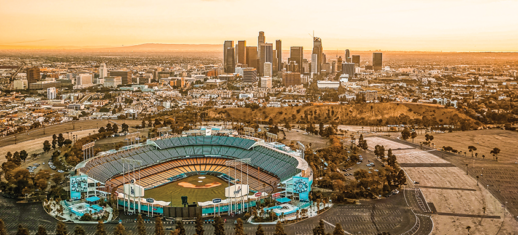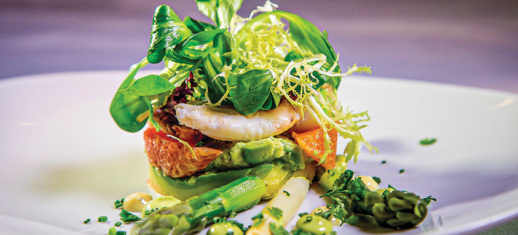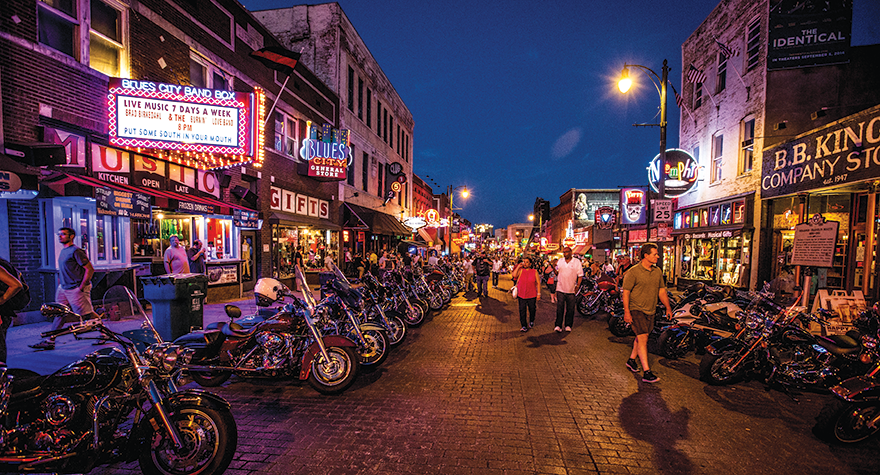“Ireland is an exotic island in the Atlantic Ocean,” says Bernard O’Reilly, president of Joe O’Reilly Ireland Group, the oldest independent destination management company in Ireland. “It is only 300 by 150 miles wide, so it’s intimate. And island people are different from mainland people. We have a genuine sincerity about us.”
Cliffs of Moher

The visitor center at the famed Cliffs of Moher on the west coast in County Clare was built into the hillside so as not to detract from the stunning landscape. The center’s interior is notable for sustainable design and development, and is showcased as part of Irish Design 2015.
This year Ireland is shining a spotlight on a decidedly modern aspect of the Emerald Isle: contemporary Irish design and craft, touching on everything from architecture and furniture to animation and medical devices. Those lucky enough to meet in Ireland can experience Irish Design 2015 (ID2015), an ambitious yearlong, government-sponsored initiative to showcase both the country’s design and craft, and the talent behind them, through high-profile events in Ireland and around the world.
The goal is to demonstrate that Ireland is well-positioned to be the heart of a creative and forward-thinking world economy—and simultaneously spur investment, employment opportunities and presumably more international meetings in the country. ID2015, organizers say, can build a better future by design, with themes that promote a “sense of place, sustainability, creativity and well-being.”
It is one more reason to meet in Ireland—as if you needed more.
Global Economy
 Wexford Opera House
Wexford Opera House
Ireland attracted 7.3 million visitors in 2014, which brought in $4.6 billion in revenue. Tourism Ireland officials hope to bump the figure up to 7.7 million this year, and are targeting the United States as one of several key markets.
Ireland is also a thriving business hub. “Ireland has one of the world’s most globalized economies,” says Alison Metcalfe, executive vice president for the United States and Canada at Tourism Ireland. She adds that “1,033 overseas companies choose us as their European base. Eight of the top 10 global information, communication and technology firms live here and nine of the world’s top 10 pharmaceutical firms call Ireland home. In recent years we have acquired presence of the 10 largest online companies.”
O’Reilly notes that Ireland’s roadways, transportation and meetings infrastructure have greatly improved in recent years. There is now direct access from United States not only to Dublin Airport (DUB) in the capital but also to Shannon Airport (SNN) on the west coast. “The beauty of it [for Americans] is on returning, you arrive domestic, because there is immigration and customs at both Dublin and Shannon airports,” O’Reilly says.
Upgraded internal roadways and transportation systems make travel around the country quick and easy. Lodging options range from luxurious castles to contemporary hotels. Meetings can take place at said castles or at modern, purpose-built conference centers that can accommodate thousands.
Dublin, in fact, has become a hugely successful meetings hub: In 2014 it climbed nine places from the previous year to become 13th in the world rankings of the International Congress and Conference Association (ICCA), and this year the Dublin Convention Bureau hopes to pull in almost 60,000 delegates, some 20,000 more than in 2014.
Global Economy
 Medieval Museum, Waterford
Medieval Museum, Waterford
“Research shows that when an international conference chooses our capital city as a venue, they benefit from a ‘Dublin bounce’ with approximately 10 percent more attendees for their event, due to the reputation of the city as a lively venue to attend,” said Paul Keeley, director of business development with Failte Ireland (the National Tourism Development Authority) at a news briefing in December.
Besides its many charms, the city has Convention Centre Dublin, built in 2010. Its atrium boasts windows that run the full height of the building, with panoramic views of the bay, the River Liffey, the city and the Dublin Mountains. Within steps of city center hotels and restaurants, it has 50,000 sq. ft. of meeting and exhibit space and hosts up to 3,000 in 22 rooms and halls.
Other parts of the country, of course, also offer first-rate venues and accommodations. Venues that host large groups include Belfast Waterfront Hall, with a main auditorium that can handle 2,200, and Killarney Convention Centre in County Kerry in southwestern Ireland, which can host up to 2,500. Both are centrally situated so nearby hotels and restaurants are plentiful.
If it’s a bit of splendid isolation your group craves, Ireland can do that, too. Legendary castles, country manors and world-renowned golf resorts abound.
And, ah yes, the landscapes, from rugged mountain to limpid lake to sheer cliff. A must-see is The Wild Atlantic Way, 1,600 miles along the untamed west coast. Launched in 2014, it is the longest designated driving route in the world.
Irish Design and Craft
 Room by Designgoat
Room by Designgoat
ID2015 organizers anticipate that visitors will be as entranced by the country’s modern craft and design as they are by its historic and natural gems.
The flagship exhibition of lD2015 is “Irish Design Here/Now,” which takes place at Dublin Castle and runs July 2 to Sept. 20. The exhibition will call attention to Ireland’s creative output beyond literature, music, theater, film and art, “charting the creative development of Irish design from [furniture designer and architect] Eileen Gray through Kilkenny Design workshops to today,” says Aileesh Carew, Tourism Advisor at ID2015.
“I personally am also looking forward to ‘Appetite for Design,’ an exhibition featuring the work of leading Irish designers, architects, cooks and restaurateurs which will document, discuss and speculate about the design of food and our experience of it,” Carew says. “This show will open in Kilkenny—which has an excellent and growing food scene, and will then tour.”
Carew says ID2015 is actively reaching out to groups that either have already made plans to meet in Ireland this year or are considering it. Specifically, the business tourism division of Failte Ireland is making contact with groups to advise them of ID2015 and the special events surrounding it.
Irish Design and Craft
 Portable Barbacue by Design Partners
Portable Barbacue by Design Partners
The overall goal of ID2015, besides raising the visibility of design and craft, is to create 1,800 jobs and promote exports. ID2015 also aims to help jumpstart 200 new design-led startups, showcase more than 300 companies in international trade missions and events, and bring Irish design to an audience of more than 3 million at home and abroad.
For example, this past November, 300 photographs of 24 of Ireland’s celebrated designers and artisans at work in their studios were installed at Dublin Airport. The series shows, among others, a textile designer in front of her 3-D paint layers (which are later transferred to fabric), an industrial designer inspecting his collection of watches, and a milliner who works both traditional wooden blocks and experimental materials. More than 21 million passengers will see these photos through the end of 2015, creating awareness of individual and collective talent and hopefully creating business opportunities.
Literary Light
Yet another reason to visit Ireland in 2015 is the special celebrations planned for William Butler Yeats. This year marks the 150th year since Yeats’ birth on June 13, 1865. Ireland’s Yeats2015 program showcases the creative and cultural vibrancy of contemporary Ireland while paying tribute to the great Irish poet.
The yearlong celebrations will include Yeats Day (June 13) and feature exhibitions, performances, festivals and events throughout Ireland, including in Sligo (Yeats’ spiritual home) in the northwest.
“The world is full of magic things, patiently waiting for our senses to grow sharper.” One of Yeats’ best-known lines, it is especially true of the country he loved and that waits to be experienced.
Q&A with Sam Johnston
Business Tourism Officer, Dublin Convention Bureau
What makes Dublin a great meeting city?
We have the people—some say the friendliest in the world. Dublin is a multicultural, cosmopolitan city with a young population. At its heart are the locals, who are inherently nosy and like to talk and find out more about you. We like to make sure you enjoy your experience of Dublin and are more than happy to impart our thoughts and knowledge to help.
Dublin is headquarters to major international companies in IT, pharmaceutical, medical devices, finance and many other sectors. To have so many based here with large workforces draws attention to the city as a place where business is done at the highest of levels, on a day-to-day basis or at a convention.
How have the openings of Convention Centre Dublin (CCD) and Aviva Stadium impacted the meetings industry in your city?
In 2010 we had these two venues open as well as the new Terminal (T2) at Dublin Airport, so it was a really important time for Dublin. We had fantastic new facilities to tell the world about. Obviously the sales to fill these venues didn’t just start when the doors opened, so we saw immediate returns.
Having a dedicated convention center also put Dublin on the map internationally as being a convention city. Dublin’s profile as a city that can deliver international MICE events was enhanced.
What commitment has Dublin made to sustainability?
On-the-ground initiatives like the dublinbikes network operated by the city council have completely transformed the commuting habits of Dubliners; they are also available to visitors. Dublin is almost unique in the scale of environmentally certified conference and event businesses available, and leading these are the likes of the Convention Centre Dublin, Aviva Stadium and Croke Park Stadium. These venues are supported by more than 30 hotels in the Dublin region that are also environmentally certified to internationally recognized standards.
How does the bureau support planners staging events in your city?
Our breadth of knowledge means we can offer thoughts, ideas and opinions on the product here. We also offer a venue-finding service, meaning that the proposals we send to clients contain all the options with full destination information. The hosted site inspection is key in our sales process, as we have a very high conversion rate once buyers experience Dublin and the ease of doing business here. The final part is the financial support by our partner organization, Failte Ireland, in the form of marketing to help clients grow the number of attendees.
We go way beyond these with things like ambassador programs, preparing bids, room blocks and so on. These services come with no fees nor commission.
What’s most surprising to delegates when they meet in Dublin?
The ease of getting into the city and how close everything is, making it so easy for them to get around. And Irish cuisine hasn’t always had a good name internationally and there was a time when we wouldn’t argue with that. But over the last 10 to 15 years the food offering here has come on by leaps and bounds, spearheaded by the use of locally sourced and seasonal produce available in so many of our restaurants and pubs.
What are the most popular offsite venues for receptions and galas?
The Guinness Storehouse offers something very different from spaces at the Royal Dublin Society, which in turn differs from the simplicity of the Round Room at the Mansion House. Smaller groups enjoy the music and dance at Old Jameson Distillery and the history in Trinity College’s Dining Hall. We have two large sports stadia, the Aviva, home to soccer and rugby, and Croke Park, home to hurling.
What are your personal favorite attractions in Dublin?
I never tire of The Long Room in the Old Library at Trinity College. The vaulted ceiling is stunning, and the smell of 250,000 of the university’s oldest books is incredibly distinct. The second is being able to quickly escape the city and be on the coast listening to the sea. And last has to be the perfect pint of Guinness, which can be found in plenty of spots across Dublin.
What contributed to Dublin’s jump up to No. 13 in the 2014 ICCA rankings?
A lot of hard work from Dublin Convention Bureau in converting leads, from trade partners in supporting the bureau and from colleagues in Failte Ireland who conduct the research and put the information together. The investment [in] new venues and hotels, and refurbishing existing ones has ensured that clients find a high quality. When the global economic crunch hit, the government reduced the rate of VAT on tourism-related products from 13.5 to 9 percent, and this has been a great boost to bidding for international conferences. The rise in the rankings cannot be left without addressing the fantastic role that our ambassadors play in convincing their international associations and their peers to meet in Dublin.
—Susan Harvey
Just in the Facts
- Ireland is divided into four provinces: Ulster, Munster, Leinster and Connacht, which make up 32 counties.
- The Republic occupies 26 counties and its capital city is Dublin.
- Northern Ireland is part of the United Kingdom and its capital is Belfast.
- Ireland’s population is 6 million, with approximately 4.2 million in the Republic and 1.8 million in Northern Ireland.
The O’Reilly Way
Bernard O’Reilly is president of Joe O’Reilly Ireland Group, founded by his father, Joe, in 1966. His take on his DMC’s success, and his picks for groups:
“We have a wealth of knowledge and experience, so we have access to certain keys to doors that others may not have. We operate on a philosophy of FOBIC: flexibility, originality, budget, imagination and creativity. We’re a one-stop shop: The planner can lie peacefully in her bed at night knowing everything has been taken care of.”
Groups with room requirements more than 250, he says, should look toward Dublin. Smaller groups have more flexibility.
Unique venues O’Reilly recommends:
Ashford Castle (pictured) dates to 1228; once home to the Guinness family; five-star luxury hotel on the shores of Lough Corrib in County Mayo; undergoing complete renovation, reopens April 2015; 82 bedrooms; modern function and event space.
The K Club in Kildare; named one of the top five resorts in Europe in the 2014 Conde Nast Traveler Reader’s Choice Awards; 10 meeting rooms, the largest can host 460 theater-style; 69 guest rooms now but will double by April 2016.
Guinness Storehouse, Ireland’s No. 1 attraction; historic building in Dublin City has a brewery, bar, eatery, shop, pouring/tasting area; space hosts up to 1500; available for buyouts.
Luttrellstown Castle in Liffey Valley, where David and Victoria Beckham married; 12 guest rooms; can host 150 for gala dinners and up to 1,500 on the castle grounds.
Resources
- Dublin Convention Bureau: dublinconventionbureau.com
- Failte Ireland: failteireland.ie
- Irish Design 2015: irishdesign2015.ie
- Joe O’Reilly Ireland Group: jorireland.com
- Meet in Ireland: meetinireland.com
- Tourism Ireland: ireland.com
- Yeats2015: yeats2015.com




